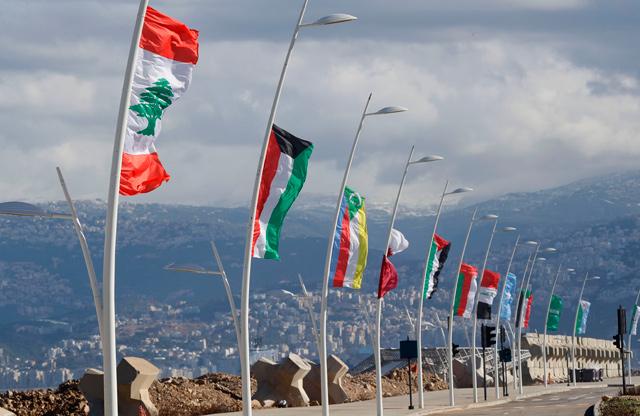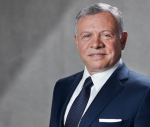You are here
Divisions overshadow Lebanon's Arab summit as few leaders come to Beirut
By Reuters - Jan 19,2019 - Last updated at Jan 19,2019

Flags of the Arab League states are seen on display ahead of the Arab Economic and Social Development Summit in Beirut on Thursday (AFP photo)
BEIRUT — Divisions among Arab states over Syria, and internal Lebanese disputes, have overshadowed a summit to be held in Beirut this weekend, with several leaders who had planned to come now staying away.
At least eight heads of state were originally expected in Beirut, said a source in the organising committee, but only the Somali and Mauritanian presidents will now join Lebanese President Michel Aoun in attending.
A big point of contention, in a region plagued by bellicose politics, is whether to welcome Syria back into the Arab fold now that President Bashar Assad has restored control over most of his country.
Lebanese Foreign Minister Gebran Bassil, at a pre-summit meeting on Friday, called for Syria to return to “our embrace” in the Arab League after being suspended for seven years.
The group’s secretary general, Ahmed Aboul Gheit, was cited by Lebanese state media on Thursday as saying there was “no Arab agreement over the return of Syria”.
The issue has played into divisions inside Lebanon, as has a row over Libya’s attendance, harking back to the disappearance of a Lebanese cleric there in the 1970s.
Lebanese leaders had hoped to agree a new government before the summit to showcase a fresh political dynamic after months of gridlock. But government formation talks drag on amid fears for the Lebanese economy.
Having closed down many Beirut streets, shutting schools and businesses in the city centre, the summit was on Friday portrayed in Lebanese media as a letdown.
“The summit of excuses and Arab disappointment,” was the headline in Al Jumhuriya daily newspaper. That of another daily, Al Nahar, was: “Beirut’s shock... a summit without presidents”.
Still, some of the 20 countries taking part in the Arab Economic and Social Development Summit are sending prime ministers, foreign ministers or finance ministers, and officials played down the notion that the meeting would be poorly attended.
“It doesn’t take away from the importance of the issues [to be decided at the meeting],” said the Arab League assistant secretary general Hussam Zaki.
Syria and Libya disputes
Although the economic summit has a lower profile than the Arab League summit, to be held in Tunisia in March, it still attracted numerous leaders when it was last held, in Saudi Arabia, in 2013.
Then, as now, Arab states were divided over the 2011 uprisings that toppled four leaders and led to three wars, over the rivalry between Saudi Arabia and Iran, and over the role of the Muslim Brotherhood.
Syria was suspended from the Arab League in 2011, but some members are pushing for its reinstatement and others have reopened shuttered embassies in Damascus.
In Lebanon, where Syrian forces were present for about three decades, the extent of relations with Damascus remains controversial.
Lebanon’s powerful Iran-backed Hizbollah fought alongside Assad in Syria and wants Arab states to normalise ties with Damascus. Some other Lebanese parties are wary of Damascus’ role.
“No Arabs without Damascus,” was the headline on Friday in the pro-Hizbollah Al Akhbar newspaper.
Meanwhile, members of the AmalParty, a Hizbollah ally, on Sunday tore down a Libyan flag near the summit venue and burned it. They are angry over the disappearance of Shiite cleric Imam Musa Al Sadr while visiting Libya in 1978.
Libya was then ruled by Muammar Qadhafi, who was overthrown in 2011, but Amal politicians accuse the internationally recognised government in Tripoli of not cooperating with investigations into Sadr’s disappearance.
The Libyan government has boycotted the summit in protest and pointed out that thousands of Libyans also disappeared under Qadhafi’s four decades of autocratic rule.
Related Articles
BEIRUT — A Libyan mission to Lebanon that was looking into the case of a son of the late Libyan leader Muammar Qadhafi who is being held by
BEIRUT — Hannibal Qadhafi, the high-living businessman son of the late Libyan dictator, was freed late Friday, several hours after he was ki
BEIRUT — Lebanese authorities on Monday charged Hannibal Qadhafi, the high-living son of the late Libyan dictator, with withholding informat















